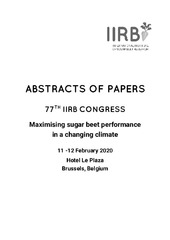Prikaz osnovnih podataka o dokumentu
Characterisation of Trichoderma spp. for antagonistic activity against charcoal root rot Macrophomina phaseolina from sugar beet
| dc.creator | Stankov, Aleksandra | |
| dc.creator | Nagl, Nevena | |
| dc.creator | Stojšin, Vera | |
| dc.creator | Budakov, Dragana | |
| dc.creator | Bagi, Ferenc | |
| dc.creator | Dudaš, Tatjana | |
| dc.creator | Ćurčić, Živko | |
| dc.creator | Isakov, Milada | |
| dc.date.accessioned | 2024-02-08T10:05:03Z | |
| dc.date.available | 2024-02-08T10:05:03Z | |
| dc.date.issued | 2020 | |
| dc.identifier.uri | http://fiver.ifvcns.rs/handle/123456789/4251 | |
| dc.description.abstract | Charcoal rot of sugar beet, caused by Macrophomina phaseolina in recent years has become a main concern for farmers in Serbia. Since control measures are mostly preventive with only partial effect, introduction of alternative measures, such as biological control based on augmentation of mycoparasites, represents the most promising approach. ITS region and tef gene sequence analysis of ten Trichoderma spp. isolates from sugar beet and soybean rhizosphere was done to confirm species identity. All isolates were confirmed to be Trichoderma harzianum. | sr |
| dc.language.iso | en | sr |
| dc.publisher | International Institute of Sugar Beet Research | sr |
| dc.rights | openAccess | sr |
| dc.rights.uri | https://creativecommons.org/licenses/by/4.0/ | |
| dc.source | Abstracts of Papers, 77th International Institute of Sugar Beet Research (IIRB) Congress "Maximising sugar beet performance in a changing climate", 11-12 February 2020, Brussels | sr |
| dc.subject | Trichoderma spp. | sr |
| dc.subject | isolates | sr |
| dc.subject | sugar beet | sr |
| dc.subject | charcoal rot | sr |
| dc.subject | Macrophomina phaseolina | sr |
| dc.subject | Serbia | sr |
| dc.title | Characterisation of Trichoderma spp. for antagonistic activity against charcoal root rot Macrophomina phaseolina from sugar beet | sr |
| dc.type | conferenceObject | sr |
| dc.rights.license | BY | sr |
| dc.citation.epage | 71 | |
| dc.citation.spage | 71 | |
| dc.identifier.fulltext | http://fiver.ifvcns.rs/bitstream/id/11422/bitstream_11422.pdf | |
| dc.identifier.rcub | https://hdl.handle.net/21.15107/rcub_fiver_4251 | |
| dc.type.version | publishedVersion | sr |


